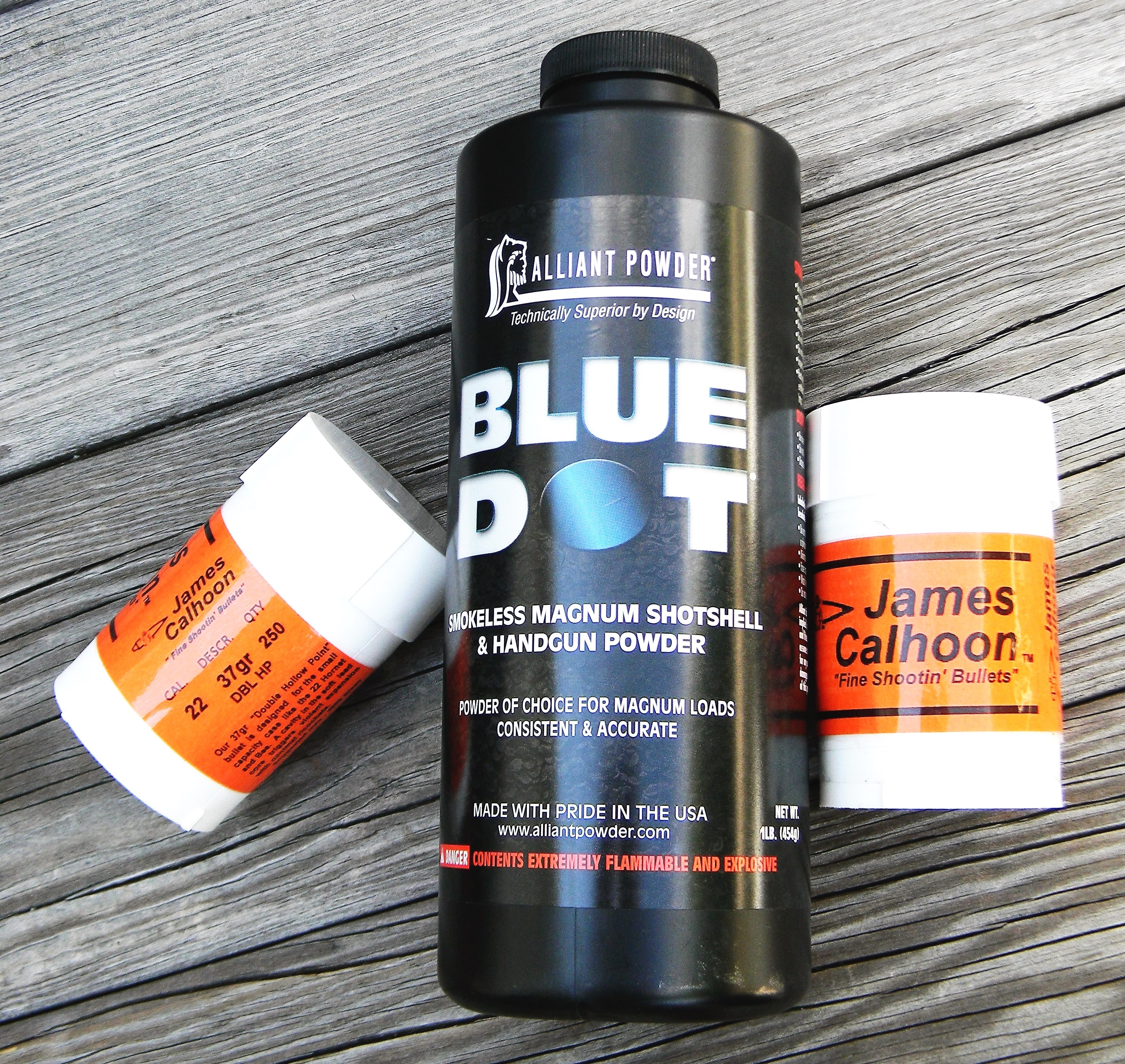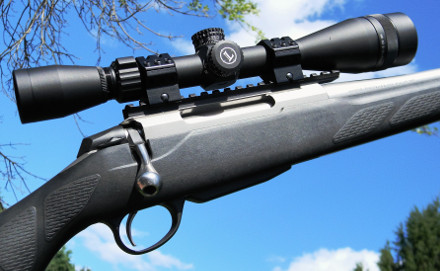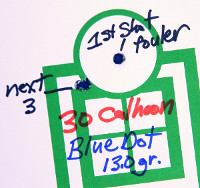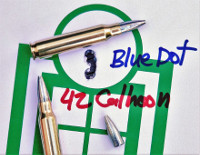
A decade ago while working with the new .19 Calhoon cartridge (an improved .22 Hornet case necked down to .192”), I became aware of James Calhoon’s
.223 Gopher Loads, using moderate charges of a faster burning flake powder. With moderate charges of Alliant Blue Dot, his 37 and 42 grain varmint bullets reach 3,200 or 3,000 fps respectively… and regularly shot around a half-inch at 100 yards from several of my .223 rifles.
The Calhoon Gopher load concept was originally developed at the request of a trapper who carried a .223 for predator hunting and used the same rifle when running his trap line in Montana. Full power loads were far too destructive when he had to dispatch an animal he’d trapped and were also rather hard on his ears. James originally tried a few other flake powders, but after some testing, found Blue Dot to be the best performer. For these moderate loads, which still deliver very good speeds, the chosen powder had to be very bulky, so double charging would not be possible. All starting loads are at least 63% of case capacity, so a double charge will spill out all over, alerting you of the error.
Producing only half to a third of normal recoil, your gun goes “pop”, as bullet after bullet usually land within a half-inch or less of each other. Then you look at your chronograph and can’t believe you’re getting 3,000 to over 3,600 fps. And after over a dozen shots, your sporter barrel is only warm… while that many full-power loads would have left it too hot to touch. So if you pace yourself to a reasonable rate of fire, in a prairie dog town, you can just keep shooting and shooting without having to stop.
Calhoon’s Double Hollow Points ( www.jamescalhoon.com ) are highly explosive varmint bullets with thin brass jackets and his exclusive Slick Silver™ electro-chemically bonded coating. The silver-colored, shinny metallic finish, which doesn’t come off on your hands, acts as a slippery bore lubricant, reducing metal fouling while also making cleaning much easier. The very thin brass he uses for his bullet jackets are more brittle than copper. And the bullets feature an additional hollow point within the lead core. The result is a bullet that “shatters” readily on impact, producing a rather spectacular on-target display.
Best of all, with Slick-Silver™ coating there are no accuracy or fouling issues, even after 150 shots. My...
first trip to the range, at the end of my shooting that many rounds, a quick check of the muzzle only showed matte-charcoal colored powder fouling with no bullet streaks in the bore from jacket fouling. Cleanup was very quick and easy with that many Calhoon’s down my Tikka’s bore. Besides pest or varmint shooting, these loads are great for practice, and especially when introducing a new shooter to the sport. The lower recoil and reduced muzzle blast make them fun to shoot, even for a first timer.

With a recent purchase of a new Tikka T3 Lite .223 rifle with a 1-10” twist rate; I thought it would be useful for shooters to see how an expanded variety of his special loads might perform. With half or less of normal load recoil and the very frangible nature of his bullets, a lot of fun can be had in the field with less muzzle blast from loads which also generate far less barrel heating. This is a very important plus when hundreds or thousands of rounds might be expended during a long shoot.
Low Barrel Heat, Low Recoil Loads
Click to LOAD DATA SHEET
A Leupold MK-AR 6-18x40mm scope was placed on my stainless Tikka sporter (NOT the heavy-barreled varmint model) having a 22.4” barrel measuring .625” at the muzzle. I used a Hornady O.A.L. modified case and tool to determine the loaded length of the three Calhoon bullets I was testing. The 37 and 42 grain bullets were seated to 2.215” and 2.240” respectively, to allow for 0.010” jump to the rifling. The much shorter and blunter nose of the 30 grain Double Hollow Point, meant for the .22 Hornet, were seated to only 2.100” to allow for adequate support in the neck.
Using the QuickLOAD ballistic program, I ran the progressive load function; keeping pressures to less than 45,000 psi- fairly moderate for the .223 Remington. That resulted in loads for the 30 grain starting at only 13.0 grains, then 14.0, 15.0 and a top load of 16.0 grains of Blue Dot. In an 8 lb. rifle, this produces only 0.9 ~...
1.2 ft. lbs. of recoil; fully one half to only a third the recoil a full-power .223 would produce. I loaded up over a dozen of the starting load with 13.0 grains, figuring I’d need them to sight in the new scope.
I visually bore sighted the barrel and scope at 50 yards on a white piece of copy paper, and amazingly… my first shot was within two inches of my point of aim. A few clicks on the turrets, and the next two rounds touched dead center left-to-right just below my point of aim. Foolishly, I decided to clean the barrel, and then went straight to my targets at 100 yards.

While I’d posted a practice target at 100 for my first fouling shots for each bullet weight, I jumped straight to the top left aiming point of target number one. Firing my first round down the cleaned barrel, I was surprised to see it land almost dead center in the circle portion of the target. I should’ve gone to the next aiming point to fire my first ever 3-shot group from the new rifle, but loaded three rounds into the magazine and regretfully fired one after another downrange.
The first round struck just a little low, and about ¾” to the left.
The second shot only served to slightly enlarge the hole from the first shot, and the third shot hardly changed the dark spot on my target, from the two prior shots!
From the photo, you can see the less than 1/8” 3-shot group; the first ever on paper at 100 yards with my new Tikka! As best as I can measure, it’s right at 0.11” for three shots… with the 30 grain Calhoon at 3,259 fps on only 13.0 grains of Blue Dot… producing less than one-ft. lb. of recoil, with very mild report. Things were off to an excellent start!
14.0 grains produced 3,428 fps and .47” 3-shot groups. 15.0 grains delivered .49” groups at just over 3,600. Finally, 3,761 was realized from the 30 grain Calhoon on 16.0 grains of Blue Dot, and producing one-half inch groups. This top load generates only 1.26 ft. lbs. of recoil, less than half a full-power .223. And at the end of shooting the preceding 16 rounds, the barrel was more than warm to the touch, but not at all hot. Half that many full-power rounds would have made the barrel too...
hot to hold.

Next up was the heavier and more aerodynamic 37 grain Double Hollow Points. Blue Dot charges tried were 13.0, 14.0 and 15.0 grains. Velocities were recorded as 3,088, then 3,233, and finally 3,393 for the top charge. The average for all three loads with this bullet was 0.56”. Either the 30 or 37 grain loads would be great for varmints or pests out to over 200 yards with the fragile construction of the Calhoon bullets ensuring humane results.
Lastly, I tired the 42 grain Calhoon’s. They also make 52s and 55s, but speeds with the faster burning Blue Dot would be too slow with top charges. And besides, any of the three lighter bullets have more than enough for 200 yard varminting. 13.0 grains drove the 42s to just over 2,940 fps, while 14.0 grains hit almost 3,100. Both of these loads combined averaged 0.61” for 3-shots at 100 yards.
Summary
Finally, I also tried the top charges with each bullet in my DPMS AR-15. Sadly, the gas volume was not enough to cycle the action, so I had to pull back on the charging handle to eject and feed the next round. Happily though, six quick shots down my barrel, and it was barely even warm to the touch. So with the consideration for having to manually work the charging handle for each shot, these Calhoon loads are also a viable option for use in an AR. They would be excellent for starting off a young or inexperienced AR shooter, as each shot has to be deliberate, just as with a bolt action rifle. It’s possible though, that a gas piston AR may eject and feed the rounds if placed in the position to allow for the most possible gas for functional operation.
With powder availability still very poor, especially for handgun and shotgun powders, I sadly had less than a tablespoon of Blue Dot left after all my testing. Even after calling around, I was unable to locate any more of this powder, which put an end to my fun.
A review of powder burning rate charts, and some toying around on QuickLOAD, resulted in a few potential new powder candidates to try for speed and accuracy. And THOSE chosen few will be the subject of the upcoming PART 2…